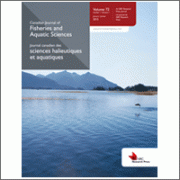An Updated Assessment of Human Activities, the Environment, and Freshwater Fish Biodiversity in Canada
AUTHOR(S): Cindy Chu, Charles K. Minns, Nigel P. Lester, Nicholas E. Mandrak
CITATION:
Chu C., C.K. Minns, N.P. Lester, and N.E. Mandrak. 2015. An updated assessment of human activities, the environment, and freshwater fish biodiversity in Canada. Can. J. Fish. Aquat. Sci. (2015) 72: 1–14. https://doi.org/10.1139/cjfas-2013-0609
ABSTRACT:
Changes in resource development and expansions of urban centres suggest that the intensity and types of anthropogenic stressors affecting Canada’s watersheds are changing. Chu et al. (2003) integrated indices of freshwater fish biodiversity, environmental conditions, and anthropogenic stress to identify priority watersheds for conservation and management. Here, we update those indices using recent climate and census data to assess changes through time. We also applied different conservation and management scenarios to evaluate the robustness of our prioritization approach. Between time periods, the environmental and stress indices expanded northward because of warmer temperatures at higher latitudes and more intense anthropogenic stress in the northern regions of the provinces.
Conservation priorities increased in northern British Columbia, Alberta, and Ontario but decreased in southern British Columbia, Saskatchewan, and south-central Quebec. Under multiple scenarios, conservation priorities were consistently highest in British Columbia, the Maritimes, southern Ontario, and southern Quebec. Future research to refine this assessment should focus on developing a nationwide georeferenced assessment of freshwater fisheries stress, quantifying spatial changes in the stressors, and evaluating the sensitivity of each index to the weighting of the individual variables. This work highlights the necessity for conservation and management strategies in Canada to keep pace with changing patterns in climate and human activities.
FULL TEXT – Chu et al.



